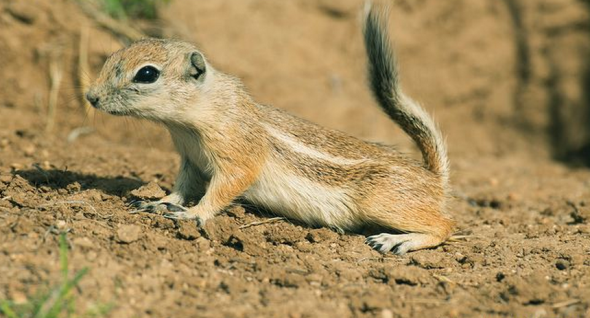Endangered Species Friday: Ammospermophilus nelsoni
Endangered Species Friday: Ammospermophilus nelsoni
This Friday’s Endangered Species Watch Post (ESP) we focus a little attention on a species of squirrel that’s rarely mentioned within the conservation or animal rights arena. A. nelsoni was identified by Dr Clinton Hart Merriam (December 5, 1855 – March 19, 1942). Dr Merrian was an American zoologist, ornithologist, entomologist, ethnographer, and naturalist. (Image; Archive, A. nelsoni)
Year of identification was back in 1893 of which the species remains endemic and extant to the United States, State of California. Environmentalists undertook two census’s of the species’s current population size, known threats and any new threats to the species back in 1996 and, 2000. Both census’s revealed few changes with regards to current status, of which the species was listed as endangered from 1996 and again in 2000.
Today the San Joaquin Antelope Squirrel as the rodent is commonly know remains at [critically endangered] level. Populations are continuing to decline within a country that one would expect to see good conservation measures increasing population sizes and, eliminating any new and past threats.
To date the current population size remains unknown which “may-well be why the species has qualified for listing on the [critically endangered] list”. Scientists undertook a rather crude population survey on three to ten squirrels per hectare on 41,300 hectares of the best and known remaining habitat. The survey then provided a rough estimate of which stated population sizes could be standing at [124,000 - 413,000]. However as the true population size is currently unknown one must not take this survey into consideration when documenting or teaching students. The following estimates were based on more in-depth multiple crude evaluations back in [1980].
Current “trend” evaluations from 1979 have confirmed that many San Joaquin Antelope Squirrel populations have unfortunately decreased throughout their known range although, even these surveys are still pretty much sketchy. A further trend evaluation survey back in 1980 revealed more-or-less the same findings from (1979) of which the species has decreased through much of its small (clustered range) manly within, San Joaquin Valley, California.
Recent protection efforts in the southwestern San Joaquin Valley likely have to some degree slowed the rate of decline and, the species remains common in [some protected areas]. Probably the rate of decline is less than 30% over the past 10 years. Nevertheless the species is still in decline over much of its range and, despite conservation efforts the San Joaquin Antelope Squirrel is sadly nearing extinction (within the wild).
Data proves for now the species has declined throughout much of its former range by some twenty percent. Back in 1979, extant, uncultivated habitat (but including land occupied by towns, roads, canals, pipelines, strip mines, airports, oil wells, and other developments) for the species was estimated at 275,200 hectares (680,000 acres, 2,752. None of the best historical habitat remained.
One study indicated that densities in open Ephedra plots and shrubless plots ranged from 0.8 to 8.0 squirrels per hectare, but all but two sites had densities of four or less per hectare. Densities on shrubless, grassy dominated sites were equal to or higher than those on shrubby sites.
The San Joaquin antelope squirrel is dull yellowish-brown or buffy-clay in color on upper body and outer surfaces of the legs with a white belly and a white streak down each side of its body in the fashion of other antelope squirrels. The underside of the tail is a buffy white with black edges. Males are approximately 9.8 inches and females are approximately 9.4 inches in length
Breeding normally takes place during late winter to early spring of which young will normally be born from the beginning of March. Female gestation normally lasts no longer than one single month. Young do not normally emerge from the den until around the first or second weeks of April. The San Joaquin antelope squirrel has only one breeding cycle during the entire year of which this is timed just right so that when young are born there is much vegetation and food for young to feed and hide within after weening. Weening of young is believed to start before the young even emerge from the den.
A. nelsoni is omnivorous, feeding mostly on green plants during the winter and insects and carrion when these are available. It occasionally caches food. The squirrels live in small underground familial colonies on sandy, easily excavated grasslands in isolated locations in San Luis Obispo and Kern Counties.
Image: A. nelsoni. Credit (Mark Chappell).
Half of the remaining habitat supports fewer than one animal per hectare, 15% of the remaining habitat supports 3-10 animals per hectare (generally four or fewer per hectare, California Department of Fish and Game 1990). The species Spermophilus beecheyi reportedly may restrict the range of A. nelsoni. Among several predators, badger is most important, and lives in small groups.
Threats
The decline is a result of loss of habitat due to agricultural and urban development as well as oil and gas exploration practices. Primary existing threats include loss of habitat due to agricultural development, urbanization, and petroleum extraction, and the use of rodenticides for ground squirrel control. Overgrazing and associated loss of shrub cover is a concern in some areas. These threats will be alleviated by the implementation of the San Joaquin Endangered Species Recovery Plan. There are some discussions that the current drought within the region “may” have a profound effect onto the species however, this concern remains just that and, no proven data surveys have shown drought to be of a threat as yet.
Thank you for reading and, have a nice weekend from all the team at International Animal Rescue Foundation.
Dr. Jose C. Depre
Environmental and Botanical Scientist.




